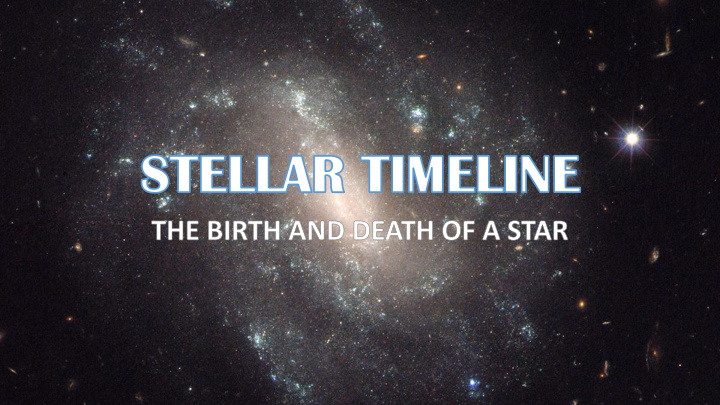



Stellar Nursery • Stars gravitationally collapse from clouds of H and He • Stars form from colder gas that allows particles to interact • Size - 411,500,000,000,000 (411.5 trillion) miles/70 Light years https://upload.wikimedia.org/wikipedia/commons/b/b2/Eagle_nebula_pillars.jpg, https://upload.wikimedia.org/wikipedia/commons/b/b2/Eagle_nebula_pillars.jpg
Collapsing Nebula and Planetary Formation • Sun and planets begin to take shape from disk of gas • Rocky planet/gas giant/ice giant locations • Size - 13,940,000,000 (13.9billion) miles/20.8 Light hours https://www.nasa.gov/sites/default/files/pia17849_1_0.jpg, https://www.nasa.gov/sites/default/
Stellar Ignition • Fusion begins in the core of the star • Solar winds clear remaining gas and dust • Planets still forming/nearing completion • Size - 9,296,000,000 (9.3billion) miles/13.9 Light hours http://wallpaperswide.com/download/star_birth-wallpaper-2880x1800.jpg, https://www.google.com/
Main Sequence • The star is in the primary phase of its life • The bigger the star the hotter it is • Some only last 10 million years (Blue Giant) • Others can last 100s of Billions (Red Dwarf) • Size - 864,575.9 mi/4.5Light seconds sdo.gsfc.nasa.gov
Stellar Expansion • Stars grow to 100x original size • Envelope inner planets • Core begins fusing heavier elements • Exist in this state very briefly compared to main sequence lifetime • Size - 92,960,000 (92.9million) miles/8.3 Light minutes http://carlsaganinstitute.org/2016/05/hunting-for-hidden-life-on-worlds-orbiting-old-red-stars/sizecomparisonsunredgiant/
Stellar Death • The star explodes and sheds its outer shell • Smaller stars Planetary Nebula • Large stars Supernova Explosion • Seed the cosmos with heavier elements • Size - 6,000,000,000,000 (6trillion) miles/1Light year http://www.supernovae.net/images/illustration.jpg, http://www.supernovae.net/
Remnants of Stellar Death • Smaller stars leave behind white dwarfs (carbon) • Larger stars leave behind either a neutron star or a black hole depending on the mass of the core (>3x mass of the Sun results in a black hole) • Ejected material goes to seed stellar nursery and forms new stars • Size - 185,900,000 (185.9million) miles/16.6 light minutes Chandra.si.edu/
The Cosmic Calendar
First stars
Gravity Draws Stars Together
First Galaxies Formed
Milkyway Formed
Our Star Formed
Earth Forms .
Moon Formed
First Life Formed on Earth
First Dinosaurs Roam the Earth
First Humans
You Were Born
Image Sources • • http://nasvesmir.cz/2016/06/06/supernova-a-cefeidy-ze- https://www.thoughtco.com/what-were-the-first-stars-like-3072099 spiralni-galaxie-ugc-9391/ • https://www.muyinteresante.es/ciencia/preguntas-respuestas/que- • https://apod.nasa.gov/apod/ap011125.html son-las-galaxias-anillo-711471519922 • • https://www.a.jpl.nasa.gov/spaceimages/details.php?id=PI https://www.muyinteresante.es/ciencia/preguntas-respuestas/que- A17849 son-las-galaxias-anillo-711471519922 • • https://www.eso.org/public/images/eso0942a/ https://orbitingfrog.com/tag/star-formation/ • • https://svs.gsfc.nasa.gov/3988 https://www.tes.com/lessons/EUDCECh7Ikafmg/the-sun • • http://carlsaganinstitute.org/2016/05/hunting-for-hidden- https://news.nationalgeographic.com/news/2013/13/130710- life-on-worlds-orbiting-old-red-stars/ moon-birth-impact-science-space-cover/ • • http://keywordsuggest.org/gallery/593659.html https://sciencing.com/thick-thin-earths-atmosphere-19740.html • • http://www.ibtimes.co.uk/scientists-watch-supernova- https://www.universetoday.com/104336/how-did-life-begin/ explosion-first-time-1606326 • https://www.pinterest.com/pin/340092209341621514/ • ??? (Erin sent this) • http://darkworldsquarterly.gwthomas.org/cave-men-and-women- • http://thebestoftheinternets.blogspot.com/2014/12/wallpa dinosaurs/ per-cosmic-calendar-2015-as-shown.html • http://www.huffingtonpost.ca/2013/03/12/unique-baby- • https://www.populimag.com/universe-like-strange-broken- names_n_2863033.html hologram/
Recommend
More recommend